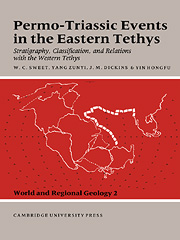 Permo-Triassic Events in the Eastern Tethys
Permo-Triassic Events in the Eastern Tethys Book contents
- Frontmatter
- Contents
- List of contributors
- Preface
- Acknowledgments
- 1 Permo-Triassic events in the eastern Tethys – an overview
- 2 Permo-Triassic boundary relations in South China
- 3 Permo-Triassic boundary of the Indian subcontinent and its intercontinental correlation
- 4 Permo-Triassic boundary on the Indian peninsula
- 5 The Permo-Triassic boundary in the southern and eastern USSR and its international correlation
- 6 Classification and correlation of nonmarine Permo-Triassic boundary in China
- 7 Permian and Triassic events in the continental domains of Mediterranean Europe
- 8 The Permo-Triassic boundary in the Southern Alps (Italy) and in adjacent Periadratic regions
- 9 Permo-Triassic brachiopod successions and events in South China
- 10 Conodont sequences in the Upper Permian and Lower Triassic of South China and the nature of conodont faunal changes at the systemic boundary
- 11 A conodont-based high-resolution biostratigraphy for the Permo-Triassic boundary interval
- 12 The palynofloral succession and palynological events in the Permo-Triassic boundary interval in Israel
- 13 The effects of volcanism on the Permo-Triassic mass extinction in South China
- 14 Geochemical constraints on the Permo-Triassic boundary event in South China
- 15 Permo-Triassic orogenic, paleoclimatic, and eustatic events and their implications for biotic alteration
- 16 Permo-Triassic boundary in Australia and New Zealand
- Index
8 - The Permo-Triassic boundary in the Southern Alps (Italy) and in adjacent Periadratic regions
Published online by Cambridge University Press: 12 October 2009
- Frontmatter
- Contents
- List of contributors
- Preface
- Acknowledgments
- 1 Permo-Triassic events in the eastern Tethys – an overview
- 2 Permo-Triassic boundary relations in South China
- 3 Permo-Triassic boundary of the Indian subcontinent and its intercontinental correlation
- 4 Permo-Triassic boundary on the Indian peninsula
- 5 The Permo-Triassic boundary in the southern and eastern USSR and its international correlation
- 6 Classification and correlation of nonmarine Permo-Triassic boundary in China
- 7 Permian and Triassic events in the continental domains of Mediterranean Europe
- 8 The Permo-Triassic boundary in the Southern Alps (Italy) and in adjacent Periadratic regions
- 9 Permo-Triassic brachiopod successions and events in South China
- 10 Conodont sequences in the Upper Permian and Lower Triassic of South China and the nature of conodont faunal changes at the systemic boundary
- 11 A conodont-based high-resolution biostratigraphy for the Permo-Triassic boundary interval
- 12 The palynofloral succession and palynological events in the Permo-Triassic boundary interval in Israel
- 13 The effects of volcanism on the Permo-Triassic mass extinction in South China
- 14 Geochemical constraints on the Permo-Triassic boundary event in South China
- 15 Permo-Triassic orogenic, paleoclimatic, and eustatic events and their implications for biotic alteration
- 16 Permo-Triassic boundary in Australia and New Zealand
- Index
Summary
Introduction
The purpose of this report is to illustrate the characters of the Permo-Triassic boundary in the Southern Alps. This was also the object of an international meeting in July, 1986, which was arranged cooperatively by the Geological Society of Italy and the leadership of IGCP Project 203. Most of the opinions expressed and conclusions reached at that meeting have been published (Cassinis, 1988). We have undertaken a further revision, however, in view of later reflections and subsequent data.
In the following report, the senior author considers the primarily marine deposits between the Adige Valley and Carnia, and compares them with deposits in adjacent Yugoslavia, whereas the junior author reviews Permian continental sequences of the South-Alpine region, mainly west of the sector discussed by Broglio Loriga, and considers their contact with overlying units.
The marine Upper Permian and the Permo-Triassic boundary
Eastern Southern Alps
The Middle(?) and Upper Permian of the Dolomites and Carnia consists of two lithostratigraphic units, the Val Gardena Sandstone and the Bellerophon Formation, which taken together may be regarded as a composite transgressive sequence. The Val Gardena Sandstone consists mainly of terrigenous clastics, in part typical red beds, which were deposited in a semi-arid setting. The Bellerophon Formation is composed mostly of chemical sediments (carbonates and sulphates) and its facies associations suggest a wide spectrum of depositional environments, ranging from a coastal sabkha to shallow-shelf settings. The Bellerophon Formation wedges out westward and disappears west of the Adige Valley by gradation into continental deposits (Figs 8.1, 8.2).
- Type
- Chapter
- Information
- Permo-Triassic Events in the Eastern TethysStratigraphy Classification and Relations with the Western Tethys, pp. 78 - 97Publisher: Cambridge University PressPrint publication year: 1992
- 15
- Cited by


